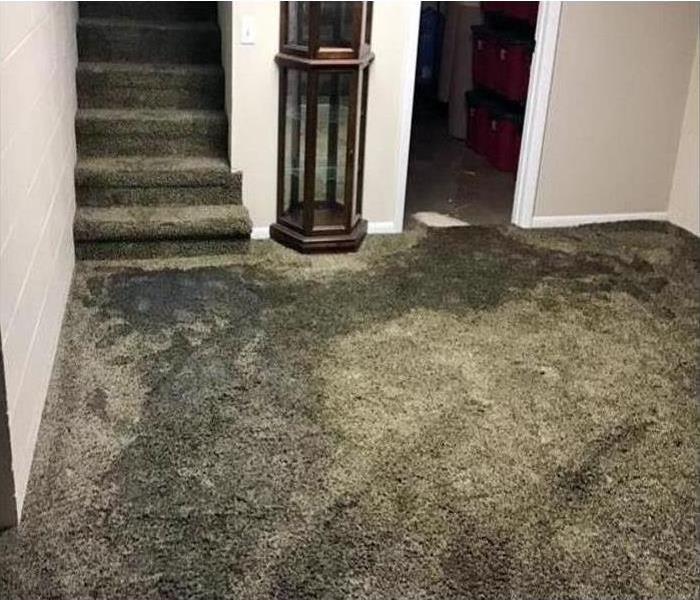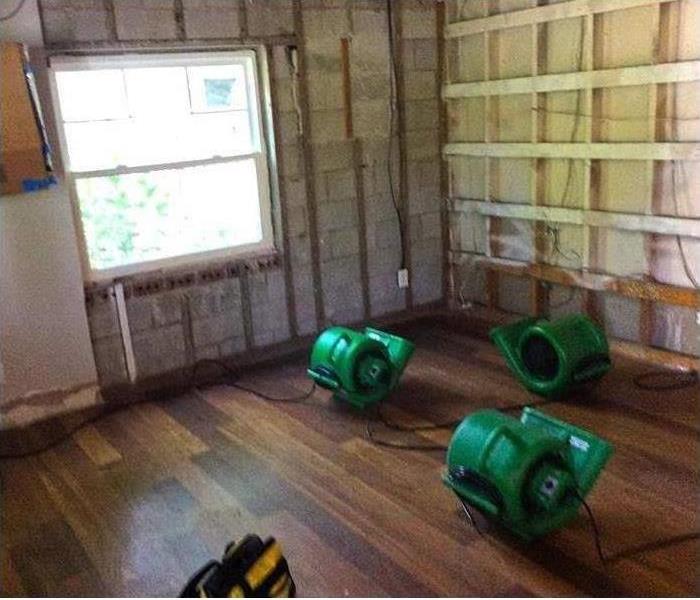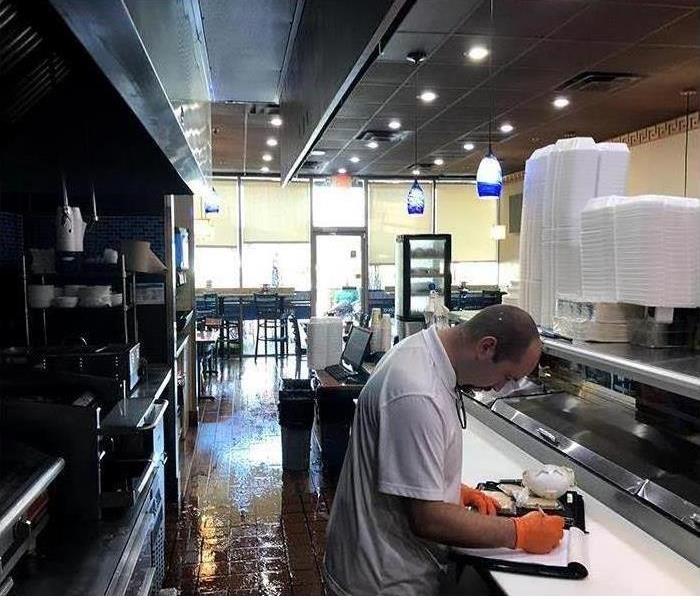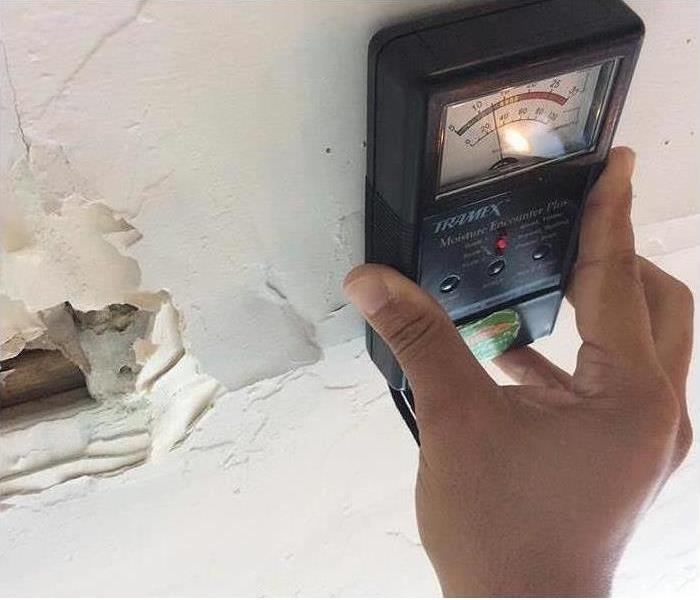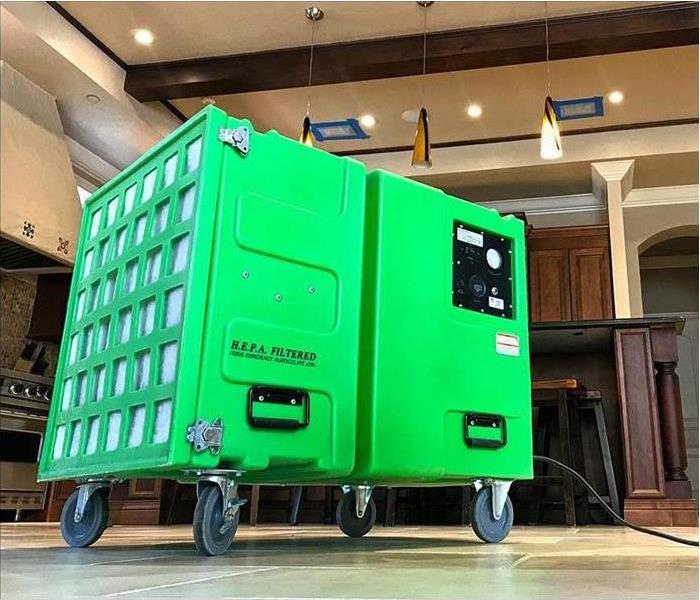Recent Posts
Comprehensive Water Damage Recovery Solutions in University, SE Orlando
2/6/2025 (Permalink)
Water damage can strike your home or business at any time, causing significant stress and costly repairs. Whether from burst pipes, flooding, or leaks, addressing water damage quickly is essential to preventing long-term issues like mold growth and structural deterioration. At SERVPRO©, we specialize in Water Damage Repair and Restoration in University, SE Orlando, ensuring your property is restored efficiently and professionally.
Understanding Water Damage
Water damage can occur for various reasons, including:
Burst or Leaking Pipes – Cold temperatures or old plumbing can lead to unexpected pipe bursts.
Flooding from Heavy Rains – Intense storms can cause water intrusion, leading to soaked carpets, damaged drywall, and structural issues.
Sewage Backups – Blocked drains or septic system failures can cause hazardous water damage.
Appliance Malfunctions – Dishwashers, washing machines, and water heaters can leak and flood rooms.
Roof Leaks – Damaged shingles or clogged gutters can result in water seeping into your home.
Recognizing the signs of water damage early can help minimize costly repairs. Look out for discoloration on walls, musty odors, or peeling paint.
The SERVPRO Water Damage Repair and Restoration Process
When dealing with Water Damage Repair and Restoration in University, SE Orlando, quick action is crucial. Here’s how SERVPRO handles water damage restoration:
1. Emergency Contact
Our 24/7 response team is always ready to assist. The moment you call SERVPRO, we gather crucial details about the situation and dispatch a team to your location.
2. Water Damage Assessment
Our professionals assess the extent of the damage using advanced moisture detection equipment. This helps us determine the best approach for drying and restoring your property.
3. Water Removal
We utilize powerful pumps and industrial-grade vacuums to remove standing water quickly. The faster the water is extracted, the less damage it can cause to your home’s structure and belongings.
4. Drying and Dehumidification
Once the water is removed, our team uses high-powered air movers and dehumidifiers to eliminate moisture trapped in walls, floors, and furniture. This step is crucial to preventing mold growth.
5. Cleaning and Sanitizing
Water damage often brings bacteria and contaminants into your home. We use professional-grade cleaning solutions to sanitize affected areas, ensuring a safe environment for you and your family.
6. Restoration and Repairs
The final step in our Water Damage Repair and Restoration in University, SE Orlando process is restoring your home to its pre-damage condition. This can include minor repairs, such as drywall patching and carpet replacement, or major reconstruction for severely damaged areas.
Why Choose SERVPRO for Water Damage Repair and Restoration in University, SE Orlando?
Fast Response Time – We are available 24/7 to mitigate water damage quickly.
Advanced Equipment – We use cutting-edge technology for efficient water extraction and drying.
Highly Trained Experts – Our team is IICRC-certified and experienced in all types of water damage restoration.
Insurance Assistance – We work with your insurance provider to streamline the claims process.
Comprehensive Services – From initial assessment to full restoration, we handle every aspect of water damage repair.
Preventing Water Damage in Your Home
While professional Water Damage Repair and Restoration in University, SE Orlando is essential after a disaster, preventing water damage can save you time and money. Here are some proactive steps:
Inspect and Maintain Your Plumbing – Regularly check for leaks and replace old pipes before they burst.
Clean Gutters and Downspouts – Prevent water buildup and roof leaks by keeping gutters clear.
Install a Sump Pump – A sump pump in your basement can help prevent flooding.
Monitor Your Water Bill – An unexpected increase may indicate a hidden leak.
Seal Windows and Doors – Proper sealing prevents water intrusion during storms.
Call SERVPRO for Water Damage Repair and Restoration in University, SE Orlando
If your home or business has suffered water damage, don’t wait—call SERVPRO immediately. Our team is ready to provide expert Water Damage Repair and Restoration in University, SE Orlando to restore your property quickly and efficiently. With our professional services, you can trust that your home is in the best hands.
Mold Remediation and Restoration by SERVPRO® of University, SE Orlando: Your Trusted Experts
8/6/2024 (Permalink)
When mold invades your home, it brings more than just an unsightly appearance – it threatens your health and the structural integrity of your living space. Here at SERVPRO®, we specialize in mold remediation and restoration, ensuring your home becomes a safe haven once more.
Restoring Comfort and Safety to Your Home
At SERVPRO of University, SE Orlando, we understand that mold can lead to distress and health concerns. Our mission is to provide prompt, thorough, and professional mold remediation and restoration services to restore the safety and comfort of your home.
Mold Problem? Call SERVPRO of University, SE Orlando Today!
Understanding the Importance of Mold Remediation and Restoration
Living in the humid climate of SE Orlando makes your home vulnerable to mold growth. Mold spores are microscopic and can spread rapidly when they encounter moisture or damp conditions. These spores not only compromise the aesthetics of your home but also pose significant health hazards. Exposure to mold can trigger respiratory issues, allergies, and other serious health problems.
Our team at SERVPRO of University, SE Orlando is equipped with the expertise and tools necessary to tackle mold infestations efficiently and effectively. We address the root cause of the problem to ensure long-term solutions. Mold remediation and restoration by SERVPRO of University, SE Orlando are designed to return your home to a healthy state, safeguarding the well-being of your family.
Our Comprehensive Mold Remediation Process
Detailed Inspection and Assessment
The journey to a mold-free home begins with a detailed inspection and assessment. Our certified professionals use advanced moisture detection equipment to identify areas affected by mold, even those hidden from plain sight. This comprehensive assessment guides our remediation strategy, ensuring no mold is left untreated.
Containment and Air Filtration
To prevent the spread of mold spores during the remediation process, we establish containment measures. Utilizing HEPA air filtration systems, we capture airborne spores, thus preventing further contamination. This step is crucial in maintaining the integrity of unaffected areas of your home.
Mold Removal and Cleaning
SERVPRO of University, SE Orlando employs advanced antimicrobial and antifungal treatments to eradicate mold colonies. We remove and dispose of mold-infested materials safely, while non-porous items are thoroughly cleaned and sanitized. Our meticulous approach ensures that your home is free from mold and its remnants.
Restoration
After ensuring the complete removal of mold, we focus on restoring your home to its original condition. This may involve minor repairs, such as replacing drywall and painting, or more extensive reconstruction, depending on the damage. Our goal is to deliver a home that looks and feels as good as new.
Preventing Future Mold Infestations
Educating homeowners on mold prevention is a key part of our service. We provide practical advice on maintaining a mold-free environment, such as regular home inspections, proper ventilation, and controlling humidity levels. These proactive measures are essential to avoid future mold problems.
Why Choose SERVPRO of University, SE Orlando for Mold Remediation and Restoration
Mold issues require immediate and professional attention to prevent escalation. SERVPRO of University, SE Orlando has built a reputation for excellence in mold remediation and restoration services. Our team is IICRC-certified, ensuring adherence to industry standards and safety protocols. When you choose SERVPRO, you’re choosing a company dedicated to comprehensive and effective solutions.
Our track record in SE Orlando speaks for itself. We bring years of experience, cutting-edge technology, and a commitment to customer satisfaction to every job. With SERVPRO of University, SE Orlando, you are guaranteed a mold remediation and restoration service that prioritizes your home and health.
Take Action Against Mold Now!
Don’t let mold compromise the safety and comfort of your home. Reach out to SERVPRO of University, SE Orlando for expert mold remediation and restoration services. Our team is ready to respond to your emergency needs 24/7. Contact us today and reclaim a safe, clean, and mold-free home.
Facing a mold problem can be daunting, but with SERVPRO’s professional services, you don’t have to face it alone. Take the first step towards a healthier home by contacting SERVPRO of University, SE Orlando.
Restoring Your Safe Haven: Fire Damage Repair and Restoration
8/2/2024 (Permalink)
A fire can be a devastating experience, leaving behind not just physical damage but also emotional turmoil. At SERVPRO®, we understand the complex challenges that come with fire damage. Our commitment to providing unparalleled Fire Damage Repair and Restoration ensures that your property is restored to its former glory—and we’re here to support you every step of the way.
SERVPRO of University, SE Orlando: Your Partner in Fire Damage Repair and Restoration
At SERVPRO, we merge cutting-edge technology with a compassionate touch to offer comprehensive fire damage repair and restoration. Our mission is to bring your home or business back to life, making it even better than before.
Comprehensive Fire Damage Repair Services
When a fire strikes, quick action is essential to mitigate further damage. Our comprehensive fire damage repair services address every facet of the restoration process, from the initial assessment to the final touches.
Initial Assessment and Safety Protocols
Our experienced team begins with a detailed inspection to determine the extent of the damage. This crucial step allows us to pinpoint potential hazards and implement immediate safety measures to protect both the occupants and our restoration team. Establishing a thorough assessment lays the groundwork for an effective and efficient restoration plan.
Smoke and Soot Removal
One of the most challenging aspects of fire damage is the residual smoke and soot, which can infiltrate walls, carpets, and furnishings. These residues pose health risks and must be addressed swiftly. Our team employs specialized equipment and techniques to eradicate smoke and soot from every corner of your property. This critical step enhances air quality and paves the way for further restoration efforts.
Advanced Restoration Techniques to Rebuild Your Property
Restoring a fire-damaged property involves more than just surface repairs; it requires addressing underlying issues to ensure a safe and comfortable environment once again.
Structural Repairs and Rebuilding
Fires can significantly compromise the structural integrity of your property. At SERVPRO of University, SE Orlando, we offer an array of structural repair services, including rebuilding damaged areas. Our skilled technicians work diligently to restore walls, roofs, and foundations, ensuring they meet the highest standards of safety and stability. Precision and attention to detail are our hallmarks, ensuring your property is safe for reoccupation.
Advanced Cleaning and Sanitization
Beyond visible damage, fire residues can leave harmful contaminants. Our advanced cleaning and sanitization procedures are designed to eliminate these hazards thoroughly. We utilize industry-leading products and techniques to clean, disinfect, and deodorize all affected surfaces, ensuring a safe and healthy living environment.
Caring for Your Belongings with Meticulous Attention
At SERVPRO of University, SE Orlando, we recognize that your property comprises more than just bricks and mortar; it's a repository of cherished memories and valued possessions. Our restoration process encompasses both physical repair and emotional recovery.
Content Inventory and Pack-Out Services
We begin by systematically inventorying and packing out all salvageable items from your home or business. Our team meticulously documents and photographs each item, ensuring nothing is overlooked. This process safeguards your possessions and allows us to work more efficiently during restoration.
Restoration and Cleaning of Personal Belongings
Once your belongings are securely stored, we employ specialized techniques to clean and restore as many items as possible. Whether it's electronics, documents, or sentimental heirlooms, we handle each item with utmost care. Our objective is to return your belongings to their pre-fire condition, preserving the memories they hold.
Reintegration and Final Touches
As the restoration process nears completion, we carefully reintegrate your belongings into your refurbished property. This final step ensures that everything is returned to its rightful place, making your property feel like home again. Our attention to detail in this phase is paramount, ensuring your transitions back to normalcy is smooth.
Call to Action:
Don't let fire damage dictate your future. Contact SERVPRO of University, SE Orlando for expert Fire Damage Repair and Restoration today. Our team is here to support you in rebuilding and recovering every step of the way.
At SERVPRO of University, SE Orlando, we're more than just a restoration company; we're your dedicated partners in recovery. With our expertise and unwavering commitment, we ensure your journey from disaster to restoration is as seamless and stress-free as possible. Trust us to help you make it "Like it never even happened."
The Ultimate Guide to Water Damage in University SE
7/23/2024 (Permalink)
Protect Your Property from Water Damage in University SE
Water damage can happen at any time and often without warning, transforming a seemingly minor leak into a severe problem in no time. If you’re a homeowner, renter, or business owner in University SE, you're likely aware of the havoc water damage can wreak. Understanding the potential issues and knowing the best way to respond are essential in preserving your property and preventing lasting damage.
Contact SERVPRO Today for Immediate Assistance “SERVPRO® is here to help you manage and mitigate water damage with fast, professional, and reliable service.”
Understanding Water Damage in University SE
Water damage in University SE can be the result of various causes, ranging from natural disasters like heavy rainfall and flash floods to everyday plumbing failures. Identifying the source of the problem quickly can significantly reduce the extent of the damage.
The Common Causes of Water Damage
Water damage often stems from one or more of the following sources:
- Natural Disasters: Heavy rains, storms, and flash floods can all contribute to water entering your property, potentially causing extensive damage.
- Plumbing Failures: Burst pipes, leaking faucets, and malfunctioning water heaters are typical culprits behind water damage.
- Roof Leaks: Poorly maintained or damaged roofs can allow water to seep through and damage the upper areas of your home.
- Appliance Malfunctions: Dishwashers, washing machines, and refrigerators with worn or faulty seals can leak and flood your living spaces.
Understanding these causes can help you take preventative measures and act swiftly to minimize water damage that could occur within University SE.
The Importance of Immediate Response
Time is of the essence when dealing with water damage in University SE. Delaying the mitigation process can lead to severe consequences. Mold growth, structural weakening, and damage to personal belongings are likely if immediate action isn’t taken.
Steps to Take When You Discover Water Damage
- Identify and Stop the Source: The first step is to find the source of the water and stop it if possible. Turn off the water main or containing the leak can prevent further damage.
- Contact Professionals: Reaching out to a professional water mitigation and restoration company like SERVPRO ensures the damage is assessed and managed efficiently.
- Document the Damage: Take photographs and make a list of damaged items for insurance purposes.
- Extraction and Drying: Professionals will use advanced equipment to extract standing water and thoroughly dry affected areas.
- Restoration: Restoring the property back to pre-damage conditions involves repairing or replacing damaged materials and structures.
Why Choose SERVPRO for Water Damage in University SE?
Choosing the right company to handle water damage in University SE is crucial for effective restoration. Here are reasons why SERVPRO is your best choice:
Rapid Response and 24/7 Availability
SERVPRO understands that water damage emergencies can occur at any time, which is why we offer 24/7 availability. Our teams are always ready to respond promptly to mitigate losses and start the restoration process immediately. A rapid response is crucial to preventing additional damage, such as mold growth and structural degradation.
Advanced Technology and Equipment
At SERVPRO, we utilize state-of-the-art equipment and the latest technology to address water damage. This includes:
- Moisture Detection Tools: These tools help us locate hidden moisture in walls and floors to ensure thorough drying.
- Industrial-Grade Dehumidifiers and Air Movers: These devices are used to dry out affected areas efficiently.
- Water Extraction Units: These units remove standing water quickly to minimize damage.
Our advanced technology ensures that we can handle all facets of water damage efficiently and effectively.
Experienced and Certified Professionals
SERVPRO’s professionals are trained and certified in water restoration techniques. They bring a wealth of experience and knowledge to handle even the most severe water damage scenarios. Our team follows a systematic approach to ensure thorough water removal, drying, dehumidification, and restoration of your property to pre-damage condition.
Comprehensive Services
SERVPRO provides comprehensive water damage restoration services, including:
- Emergency Water Extraction
- Structural Drying
- Mold Remediation
- Sanitizing and Deodorization
- Content Restoration
- Reconstruction and Repairs
We offer you a one-stop solution for all water damage issues, ensuring your property is restored quickly and effectively.
Reach Out to SERVPRO for Professional Help “Don’t wait until it’s too late – contact SERVPRO now for expert assistance with water damage in University SE. We're here to help you restore normality as quickly as possible.”
Water damage in University SE doesn’t have to mean the end of your property’s integrity and comfort. With a swift response from SERVPRO, you can mitigate the damage and start the restoration process with confidence, knowing professionals are on your side every step of the way.
SERVPRO of University SE Florida: Your Trusted Partner in Restoration
7/4/2024 (Permalink)
In the picturesque region of University SE Florida, the tranquility is often disrupted by sudden natural calamities like storms and water damage. These unexpected events can create havoc, leaving property owners grappling with extensive damage and loss. In such challenging times, SERVPRO® of University SE Florida emerges as a beacon of hope, offering comprehensive restoration services to help you get back on your feet. Our team of experts is equipped with cutting-edge technology and unparalleled expertise to handle any disaster efficiently.
Quick Response Time for Immediate Relief
Time is of the essence when dealing with storm damage or water damage in University SE Florida. The longer the delay, the worse the destruction can get. This is where SERVPRO of University SE Florida shines, providing rapid response and immediate relief.
- 24/7 Emergency Services: Disasters don’t wait for business hours, and neither do we. Our team is available around the clock to address emergencies promptly.
- Fast and Efficient: Our strategic location in University SE Florida allows for a quick response to storm damage and water damage incidents, minimizing the extent of loss and speeding up the recovery process.
- Advanced Technology: We use state-of-the-art equipment to assess and mitigate damage effectively, ensuring that your property is restored to its prime condition.
Comprehensive Storm Damage Restoration
The impact of storms can be devastating, leading to structural damage, power outages, and more. SERVPRO of University SE Florida specializes in providing thorough storm damage restoration services that cover every aspect of recovery.
- Damage Assessment: Our professionals conduct a detailed inspection to assess the extent of the damage and develop an effective restoration plan.
- Board-Up and Tarping: To prevent further damage, we offer board-up services for broken windows and doors, and tarping for damaged roofs.
- Debris Removal and Cleanup: We remove fallen trees, broken glass, and other debris, ensuring that your property is safe and clean.
- Structural Repairs: From minor fixes to major structural repairs, our skilled technicians handle all aspects of the restoration process.
Expert Water Damage Restoration
Water damage can result from various sources like burst pipes, leaking roofs, or natural floods. SERVPRO of University SE Florida provides reliable and efficient water damage restoration services tailored to your specific needs.
- Water Extraction: Using powerful pumps and vacuums, we remove standing water quickly to prevent further damage.
- Drying and Dehumidification: We employ advanced drying equipment and dehumidifiers to eliminate moisture trapped in walls, floors, and ceilings.
- Mold Remediation: Our team inspects for mold growth and uses specialized techniques to remove and prevent mold, ensuring a healthy indoor environment.
- Content Restoration: We meticulously clean and restore your personal belongings, documents, and furniture to their pre-damage state.
Customer-Centric Approach
At SERVPRO of University SE Florida, our customers are at the heart of everything we do. We pride ourselves on delivering top-notch services with a focus on customer satisfaction.
- Transparent Communication: We keep you informed throughout the restoration process, explaining each step and addressing any concerns you may have.
- Personalized Solutions: Every damage scenario is unique. Our solutions are tailored to your specific situation, ensuring the best possible outcome.
- Insurance Assistance: We assist with the insurance claims process, helping you navigate the complexities and get the compensation you deserve.
- Satisfaction Guaranteed: Our commitment to excellence and attention to detail ensure that your property is restored to your utmost satisfaction.
Preventive Measures for Peace of Mind
Beyond restoration, SERVPRO of University SE Florida also emphasizes the importance of preventive measures to protect your property from future damage.
- Routine Inspections: Regular inspections can identify potential issues before they escalate into major problems.
- Maintenance Tips: We provide valuable tips and guidance on maintaining your property and minimizing the risk of storm and water damage.
- Emergency Plans: We help you develop emergency preparedness plans to ensure that you’re ready to act quickly in the event of a disaster.
Trusted by the University SE Florida Community
SERVPRO of University SE Florida has built a strong reputation as a trusted partner in restoration. Our commitment to excellence, combined with our passion for serving the community, makes us the preferred choice for storm damage and water damage restoration in University SE Florida.
- Local Experts: As members of the University SE Florida community, we understand the unique challenges faced by property owners in this region.
- Proven Track Record: Our history of successful restorations and satisfied customers speaks volumes about our expertise and dedication.
- Community Involvement: We actively participate in local events and initiatives, giving back to the community that has entrusted us with their restoration needs.
In conclusion, when faced with storm damage or water damage in University SE Florida, you can rely on SERVPRO of University SE Florida to provide swift, efficient, and compassionate restoration services. Our team of experts is committed to restoring your property and peace of mind, ensuring that you can move forward with confidence. Contact us today for all your restoration needs.
How to Clean Up After a Sewage Backup
8/4/2023 (Permalink)
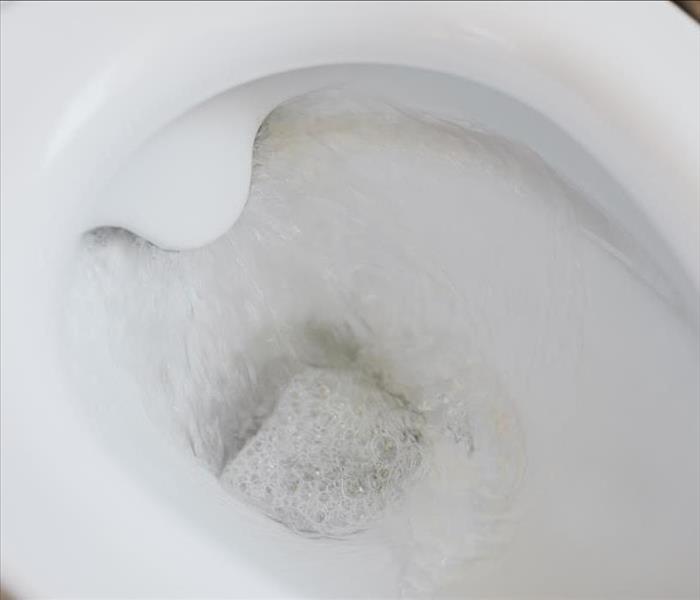 Surging sewage overflows from toilets can be a biohazard and require sanitization as well as cleanup. Some cases even call for professional help.
Surging sewage overflows from toilets can be a biohazard and require sanitization as well as cleanup. Some cases even call for professional help.
Sewage backups are a disgusting and potentially hazardous problem. If you've ever experienced one, you know how quickly the mess can spread and how difficult it can be to clean up.
If you're faced with a sewage backup, it's important to act quickly to prevent further damage. Here are some tips on how to clean up after a sewage backup:
- Turn off the water supply. This will help to prevent the sewage from spreading further.
- Wear gloves and a mask to protect yourself from exposure to bacteria and other contaminants.
- Remove as much of the sewage as possible with a wet/dry vacuum.
- Clean the affected area with a mixture of one part bleach to ten parts water.
- Rinse the area thoroughly with clean water.
- Dispose of any contaminated materials properly.
If the sewage backup is extensive, it may be necessary to call a professional restoration company. SERVPRO of University, SE Orlando is located right near I-4 near downtown Orlando for the quickest arrival times. Our team of experienced technicians will be able to clean up the mess and restore your home or business to its preloss condition.
Contact us today at (407) 954-8520 to learn more about our sewage backup cleaning services.
Here are some additional tips for cleaning up after a sewage backup:
- Open all the windows and doors to ventilate the area.
- Use fans to help dry the area.
- If there is any mold or mildew, treat it with a commercial mold remover.
- Dispose of all contaminated materials in sealed bags or containers.
By following these tips, you can clean up after a sewage backup and prevent further damage to your home or business.
How to Spot Mold Before It's Too Late
6/29/2023 (Permalink)
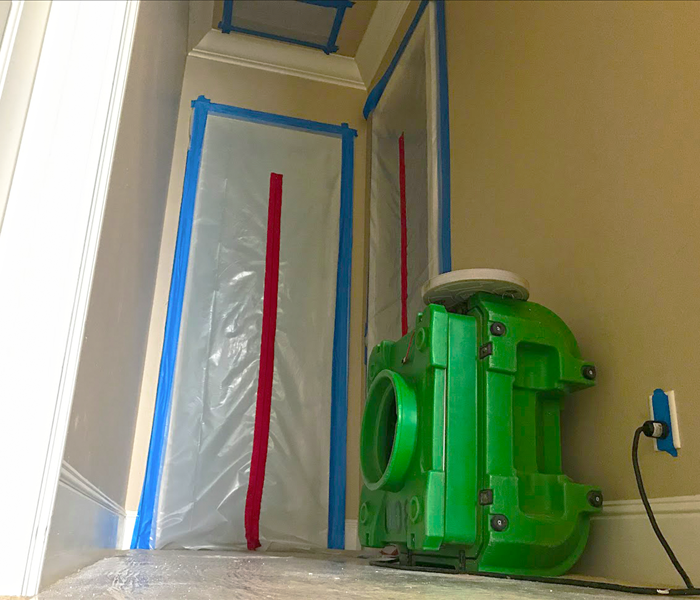 A big mistake made by many DIY property owners and even some restoration companies is not properly containing an affected area before mold removal.
A big mistake made by many DIY property owners and even some restoration companies is not properly containing an affected area before mold removal.
Mold is a type of fungus that can grow in moist environments. It is even more commonly found in Florida homes and buildings due to the moist and humid conditions. Still, it is not always easy to identify a real mold issue without experience.
Here are some of the most common signs of mold growth:
- Visible mold: Mold can appear as black, green, or white fuzzy or slimy growths. It can also appear as discolored spots or stains on walls, ceilings, furniture, and other surfaces.
- Musty odor: Mold has a distinctive musty odor. If you notice a musty smell in your home or business, it could be a sign of mold growth.
- Water damage: Mold needs moisture to grow, so if you see water damage in your home or business, it's a good indication that mold may be present. Water damage can occur from a variety of sources, such as leaks from pipes, roofs, or appliances.
- High humidity: Mold can also grow in humid environments. If the humidity in your home or business is consistently high, it's a good idea to check for signs of mold growth.
If you see any of these signs of mold growth, it's important to take action immediately. The longer you wait, the further damage to your property is likely to occur. Properly removing mold is an extensive process that can get quite costly, which is why many property owners defer to their insurance companies to cover remediation costs.
Here are some steps you can take to remove mold from your home or business:
- Identify the source of moisture. Once you've found mold, the first step is to identify the source of moisture that's causing it to grow. This could be a leaky pipe, a roof leak, or even just condensation from high humidity. Once you've identified the source of moisture, you can take steps to fix it.
- Remove the mold. Once you've fixed the source of moisture, you can start to remove the mold. Before doing so, it is recommended to properly contain the affected are so that mold spores released do not travel to other unaffected areas. You can do this yourself if the affected area is non-porous and small. Many online sources will recommend bleach, however, be cautious in doing so as using bleach on certain species of mold can cause a reaction that makes the problem worse. Instead, use organic mold treatments for cleanup.
- Ventilate the area. Once you've removed the mold, it's important to ventilate the area to prevent it from growing back. Many recommendations simply involve opening windows and doors or using a fan. A more effective method of doing so is to use a HEPA-filtered air scrubber to filter the affected air of mold spores. This should be done while containment is intact as well.
- Dry the area. Once you've ventilated the area, it's important to dry it completely. This will help to prevent the mold from growing back. You can dry the area by using a dehumidifier or by running fans.
If you're not comfortable removing mold yourself, you can hire a professional mold remediation company. These companies have the experience and expertise to remove mold safely and effectively. They also have the proper equipment to get the job done. Reputable and responsible remediation companies will require a written protocol from a licensed assessor to understand the exact mold issue in your property including, species, areas of the property affected, spore counts in the air, and proper steps for remediating the specific species of mold.
By following these steps, you can remove mold from your home or business and prevent it from coming back.
Here are some additional tips for preventing mold growth:
- Fix any leaks or water damage as soon as possible.
- Increase ventilation in your home or business.
- Use dehumidifiers to control humidity levels.
- Clean and disinfect regularly.
- Store damp items in airtight containers.
- Inspect your home or business for mold growth regularly.
By following these tips, you can help to keep your home or business mold-free.
Understanding Different Types of Fires: Prevention, Extinguishing, and Post-Fire Cleanup
6/23/2023 (Permalink)
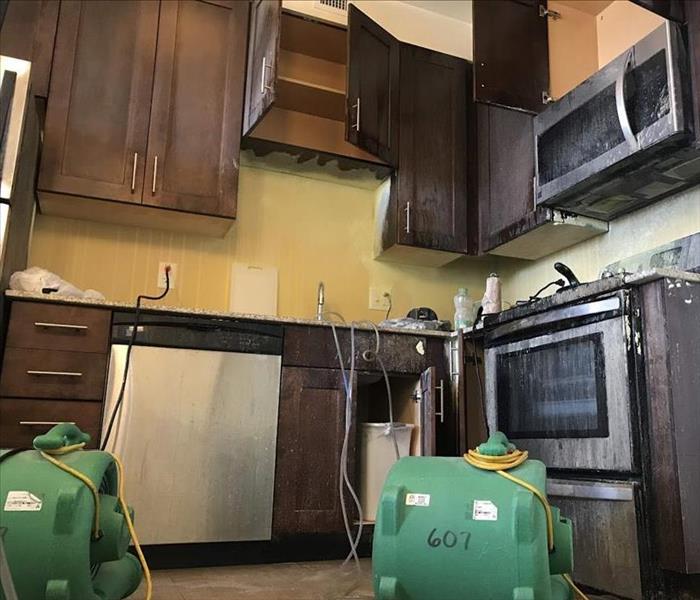 This photo of a kitchen after the fire department left is one example of the amount of cleaning that is left to be done.
This photo of a kitchen after the fire department left is one example of the amount of cleaning that is left to be done.
Navigating the Flames: Types of Fires and Post-Fire Cleanup
Fires can be devastating, causing immense damage to homes and commercial spaces. Understanding the different types of fires, how to extinguish them effectively, and the appropriate cleanup methods afterward are essential for safeguarding lives, minimizing property damage, and ensuring a thorough restoration process. In this article, we will explore the various types of fires that can occur in residential and commercial settings, discuss their extinguishing techniques, and outline the appropriate cleanup procedures post-fire.
- Class A Fires: Combustible Materials
Class A fires involve ordinary combustible materials such as wood, paper, cloth, and plastics. These fires are commonly caused by electrical malfunctions, smoking materials, or cooking accidents. To extinguish Class A fires, the most effective method is to use water or water-based extinguishers. Proper post-fire cleanup includes removing debris, assessing structural damage, and thoroughly drying the affected areas to prevent mold growth.
- Class B Fires: Flammable Liquids
Class B fires involve flammable liquids such as gasoline, oil, grease, or solvents. These fires can occur in kitchens, garages, or industrial settings. It is crucial to never use water to extinguish a Class B fire, as it can spread the flames. Instead, flammable liquid fire extinguishers or dry chemical extinguishers should be used. After a Class B fire, proper cleanup involves removing any remaining flammable liquids, ventilating the area, and conducting a thorough inspection for hidden damage.
- Class C Fires: Electrical Equipment
Class C fires involve energized electrical equipment, such as faulty wiring, appliances, or overloaded circuits. These fires can pose a significant risk due to the potential for electrocution. The first step in extinguishing a Class C fire is to de-energize the electrical source. Using a carbon dioxide (CO2) or dry chemical extinguisher designed for electrical fires is the safest approach. Cleanup after a Class C fire should involve conducting a professional inspection of the electrical system, repairing any damaged wiring, and replacing affected appliances or equipment.
- Class D Fires: Combustible Metals
Class D fires involve combustible metals, such as magnesium, titanium, or sodium. These fires are often found in laboratories or industrial settings where these metals are present. Specialized dry powder extinguishers specifically designed for the type of metal involved should be used to suppress Class D fires. Cleanup post-fire should be handled by professionals trained in handling hazardous materials to ensure proper disposal and decontamination.
- Class K Fires: Kitchen Fires
Class K fires occur in commercial kitchens due to grease and cooking oil ignitions. These fires can spread rapidly and cause significant damage if not extinguished correctly. Specialized wet chemical fire extinguishers should be used to smother the flames and cool the burning oil. After a Class K fire, thorough cleaning and degreasing of affected surfaces, ventilation of the area, and inspection of the kitchen hood and exhaust system are necessary.
Conclusion:
Understanding the different types of fires that can occur in homes and commercial spaces is crucial for effective fire prevention, extinguishing techniques, and post-fire cleanup. By knowing the appropriate methods to extinguish each type of fire and implementing proper cleanup procedures, we can mitigate damage, ensure safety, and restore properties to their pre-fire condition. Remember, fire safety is everyone's responsibility, so stay informed, be prepared, and prioritize professional assistance when dealing with the aftermath of a fire.
Understanding the Key Differences between Commercial and Residential Water Damage Restoration
5/31/2023 (Permalink)
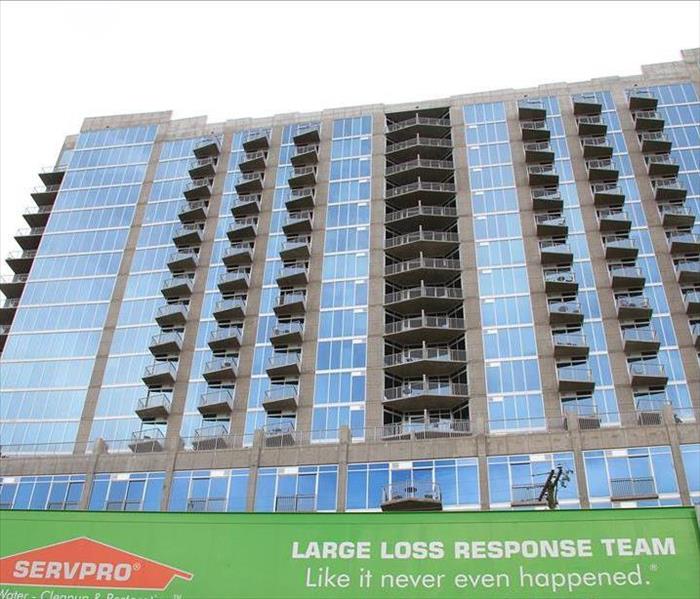 One of the key differences in commercial restoration jobs is the potential for an immensely larger scope of damage when compared to residential jobs.
One of the key differences in commercial restoration jobs is the potential for an immensely larger scope of damage when compared to residential jobs.
Water damage can wreak havoc on both residential and commercial properties, causing significant disruptions and financial losses. While the goals of water damage restoration remain the same in both settings – to mitigate damage and restore the property to its preloss condition – there are distinct differences between commercial and residential restoration jobs. In this blog post, we will explore these differences and highlight the expertise of SERVPRO of University, SE Orlando, a trusted restoration company with over a decade of experience serving both residential and commercial clients in Central FL.
Scope and Scale:
One of the primary differences between commercial and residential water damage restoration jobs is the scope and scale of the damage. Commercial properties are often larger and more complex than residential properties, with multiple floors, intricate HVAC systems, and a higher volume of occupants. Consequently, the damage caused by water incidents can be more extensive and affect a larger area in commercial buildings. SERVPRO of University, SE Orlando has the expertise and resources to handle the complexities of commercial restoration, including the ability to work on a larger scale and manage intricate systems.
Business Continuity:
Unlike residential properties, commercial properties are often places of business, where interruptions due to water damage can lead to significant financial losses. Therefore, commercial water damage restoration focuses not only on mitigating damage and restoring the property but also on minimizing downtime and ensuring business continuity. SERVPRO of University, SE Orlando understands the urgency in commercial settings and works swiftly to restore the property, enabling businesses to resume operations as soon as possible.
Specialized Equipment and Techniques:
Commercial water damage restoration often requires specialized equipment and techniques that may not be necessary in residential settings. This includes high-capacity water extraction tools, large-scale drying equipment, and specialized dehumidification systems. SERVPRO of University, SE Orlando stays up to date with the latest technology and possesses the necessary equipment to handle both residential and commercial restoration jobs effectively.
Collaboration and Coordination:
Another crucial aspect of commercial water damage restoration is the need for coordination and collaboration with multiple stakeholders, such as property managers, business owners, tenants, and insurance adjusters. SERVPRO of University, SE Orlando has extensive experience working closely with commercial clients, understanding the importance of effective communication, and ensuring all parties are informed throughout the restoration process.
Conclusion:
When it comes to water damage restoration, understanding the key differences between commercial and residential projects is essential. SERVPRO of University, SE Orlando is a trusted restoration company with over a decade of experience serving both residential and commercial clients in Central FL. With their expertise in handling complex commercial restoration jobs, they can effectively mitigate damage, restore properties to their preloss condition, and ensure business continuity. Whether it's a residential or commercial water damage restoration job, SERVPRO of University, SE Orlando is equipped to provide reliable and efficient services. Contact them today to experience their exceptional restoration services for yourself.
Commercial Fire Safety and Prevention Tips
6/13/2022 (Permalink)
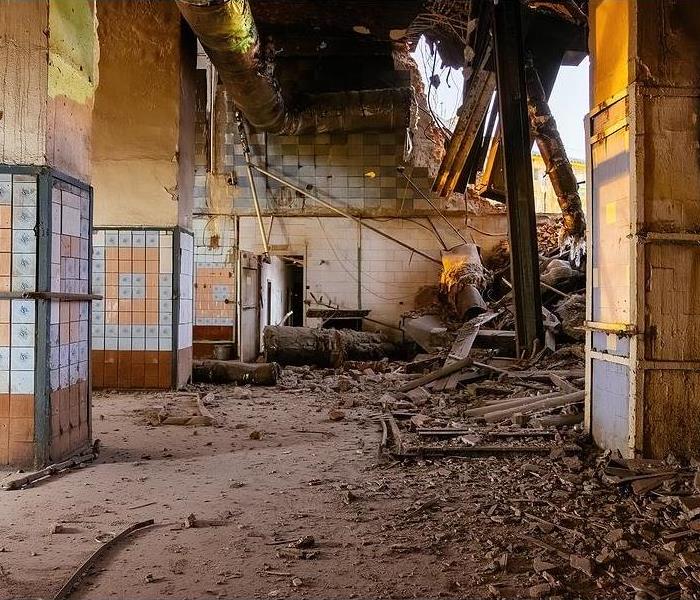 Hiring a professional company with experience is the only way to get past the damage that can be done by fire in a commercial space.
Hiring a professional company with experience is the only way to get past the damage that can be done by fire in a commercial space.
A fire can quickly become a horrific event that destroys property, endangers lives, and leaves the occupants with limited resources to rebuild. But fires in commercial spaces can also be a costly business interruption. Fortunately, there are steps that companies can take to reduce the possibility of fire in their space while maintaining productivity and avoiding potential legal liabilities.
Tips for Fire Safety and Prevention in a Commercial Property
A comprehensive fire prevention plan for an office or retail space includes a range of steps, from providing adequate smoking areas and removing combustible items from the premise to testing alarms and forming an evacuation plan. Some states mandate that companies with a certain number of employees have a business fire safety plan. Here are five additional tips for ensuring safety by preventing fires in commercial spaces:
1. Designate an area outside that space for smokers to use. Many fires start through smoking materials or careless disposal of smoking materials. Designate a smoking area away from the building and any flammable material, with adequate drainage to protect the soil from cigarette butts and ashes. Choose an area that is covered to keep people dry in the case of rain or snow.
2. Consider using fire-resistant tape on floors, carpets, and drapes, especially in high-traffic areas. It is inexpensive and may prevent the rapid spread of fire. Be sure to follow the manufacturer’s instructions for proper use.
3. Keep matches and lighters out of children’s reach and in a locked drawer. Children have many chances to experiment with fire during their childhood years—either on purpose or unintentionally. The result of a child playing with fire could be an awful tragedy.
4. Install smoke detectors in all commercial spaces, particularly near sleeping areas or areas where paper is burned. Smoke detectors will be your first warning in case of fire, so the fire doesn’t get the upper hand.
5. Keep a fire extinguisher handy. An ABC-rated (A-B-C) fire extinguisher near common areas can offer a better chance of rapid containment of a small fire before it gets out of hand. Fire extinguishers should be regularly tested and maintained to ensure they are ready to use if needed.
Avoiding fire hazards in a commercial space is not difficult but does require some effort. These simple steps can help keep you and your employees safe and protect your investment against the risks of fire. And when the proper measures are taken to prevent fires, occupants can focus on their work instead of worrying about a potentially life-threatening event.
Fire safety is a responsibility that falls to all parties involved in managing a commercial space—from the owners to the manager and staff to any visitors. By following these simple steps, building occupants can have peace of mind knowing that they are doing their part in fire prevention.
Fires can be devastating, and the victims of such tragedies are usually left with limited resources to rebuild. Those in charge of the property must know how to create an effective fire safety plan for their commercial spaces and follow their plan. But even if you follow your plan meticulously, you may still face costly consequences. When a fire takes place, it’s essential to know what happened so you can gather evidence that can help win your case.





 24/7 Emergency Service
24/7 Emergency Service
